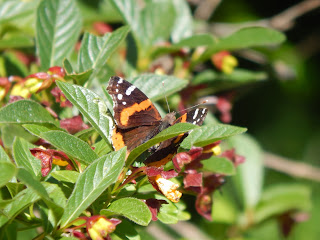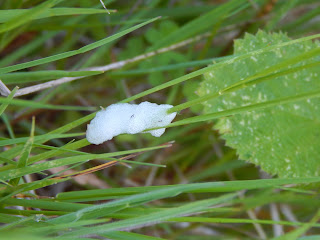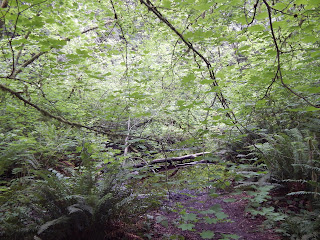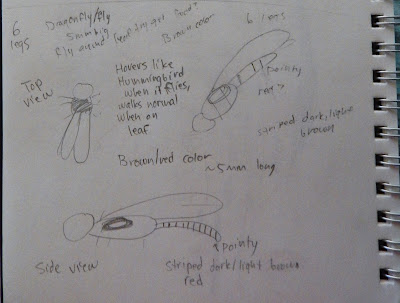This week we went to Whidbey Island to visit beloved Beth's totally rad Skyroot Farm and to explore Ebey's Landing. I live so close to this island, yet I've never actually been to explore it.
Skyroot Farm is a very diverse little world harboring many different ecosystems all within that one land plot. In it we saw riparian habitat, prairie habitat, forest habitat, heavily managed farming habitat, and more but these are the ones I remember most.
When I heard we were going to a farm, my first thought was "uhhhhh, boring! There's nothing to see there!" Boy was I wrong. The first thing I noticed when entering the farm were the chicken--the amazing chickens! One I designated Big Bird because she looks like Big bird from Sesame Street. It's a
Chamois Polish Chicken I believe, since those are the only hens that look like Big Bird. But that's not native to the northwest. But I was super happy that I figured out the species of the bird!
 |
It's Big Bird!!!!!!!!!!!
|
As we walk into the entrance of the farm, I see the actual farm with plants and flowers! But that's not really part of this journal so I'll skip what I saw.
When we split up as groups, I joined the forest group, which turned into the riparian zone group, which turned into a little mini tour group. The first thing I notice in the forest is how young it is. There is virtually no understory, except with a few ferns and knocked down wood here and there. It was littered with slugs! I found a
Black slug, which is actually invasive to the area since it outcompetes with the banana slug and also consumes fungi that is important in the ecosystem. They usually prefer moist environments, so most were found near the water but some were found in the drier spots of the forest. I also saw
Banana slug . The forest consisted of the typical trees we've learned:
Douglas Fir, Redcedar so nothing really new or interesting. The forest was dry and cool from the upper canopy blocking direct sunlight and rain going down.
 |
| Black slug. It looks cut in half and dead... Unless it's a baby. It was hanging around near the wet area. |
Moving down to the water zone, there is a sudden shift of forest into a riparian zone. What was shaded, uneven, cool,, and big tree filled turned into a semi-open, wet, thin tree area. There in the zone we found lots of
common horsetail and
Red Alder. This area had bushes blooming so there were more insects around. Butterflies were flying over and around the areas. Butterflies rested on the
Lady fern and bushes nearby. Both Horsetail and Alder need constant water sources since they aren't good at retaining water, therefore explaining their abundance in the riparian zone. The creek was actually smaller than I thought. Around it were birds, and is a good spot for birds to nest. The butterfly below was flying around and landing on the bushes. It looks as if its trying to camouflage itself or to gather pollen/nectar and spread it to other places.
 |
| Lepidoptera order! It looks like it's hiding from predators (us) or transporting pollen from one place to another. |
Exploring the farm was a lot of fun. My favorite was observing bees do their thing. I have an affinity with bees. I think they're so awesome and little, and are my favorite flying critters. Walking around the actual farmed plants, I saw the
honeybees flying from flower to flower trying to get some nectar. I also found
bumblebees doing the same thing, but bumblebees are predatorial and eat smaller honeybees. Both bees rarely stayed still for me to get a decent picture in.
I liked watching the birds, but it's so difficult knowing what they're doing when they're so far away. The
Songsparrow Tim caught was my first time seeing a live bird up so close. I could see the evolutionary history of the bird being related to dinosaurs. The claws are talon like and scaly, as with their legs. The wings are like little fingers for birds filled with bones. I think the best part I saw was when the bird pooped on Hannah and she forgot and touched her hair! The cutest part is when the bird opens its beak. The bird was male because only they would be aggressive enough to fly into a net and get caught. It was obviously stressed out a bit.
 |
Tim and Jorge giving lesson on Songsparrow. How to measure and the history of it.
|
I really liked Tim's discovery of the little frog. I think it was a
red-legged frog? I'm not sure if that was the right identification we came up with. I don't remember anything about it, but it was cute.
 |
| Red orange legs of the frog. The way we tried identifying it. |
 |
| Calmly sitting in Shelby's hand. It's soft, squishy and slimy. The frog kept wanting to jump away. |
And although this technically isn't native northwest species interactions, the chickens were the best display of competition I saw all day. The two males constantly competed with each other to be top dog and get the hens. I noticed that when I got close to a hen, the rooster would come out and puff up his chest and look intimidating. It was cute. But when the two roosters were together they didn't seem to fight. They were just calling.
 |
| This rooster tried to intimidate me. It seemed to be protecting the hens and acting territorially. |
Up on the meadow prairie there were lots of
Cleaver. They are edible herbs and are Native! I wonder if Beth planted these, or if these naturally came after they manually cut out all the Blackberries.
 |
| Cleaver growing out in the meadow prairie field. |
There were lots of these
Spittlebug like things on grass. These bugs are drawn to moist areas, so most of them were found in the parts of the farm nearest the water and shaded areas. The bug feeds on the grass. The spit helps to protect the baby bugs called nymphs while they feed until adulthood. These are pests and could greatly hurt Beth's grassy farm. I'm not sure if there are any benefits of having them around.
 |
| Cool spit bug things. They live in this spit like thing to protect the babies! |
The landscape picture I decided to draw incorporated three different types of habitats. In the far back is the coniferous evergreen forest, where the trees are tall and have pine needles. In front of that are shorter and rounder deciduous broadleaf trees. In the middle is
 |
| Skyroot Farms sketch. It's not the best since I have trouble drawing plants. But you can see how there's different landscapes. There's the coniferous forest largely looming in the back. In front you see broadleaf deciduous trees. Then in the middle we see Alders and the water zone, along with a random brown patch of grass I still don't know anything about. |
One of the insects we caught was a Pill Bug I assume.
 |
| Pill Bug! This bug was fun to watch. Note, it was difficult for me to count the legs, so I drew what I saw. It's not representative of what the legs look like. All other things are as accurate as I could draw. |
|
|
Next we went to Ebey's Landing. Here we got to see what was on top of the cliff area. It's interesting that the landing had two types of ecosystems: one marine and one mountainside like. Near the walkway up the stairs I see a
Red winged blackbird perched and surveying the area. We were in his territory, but there was no other bird around. Walking up the mountain gave a beautiful view of the mountains. Looking across the fields, I notice a farm and the patch of land they work with. Compared to the mountainside, the farm field looked odd. It's a reminder that people are using agriculture to their advantage. Walking up I found very few birds and mammals, but lots of plants. We found the
Prickly pear cactus! It was smaller than I thought. These prickly pears enjoy very dry areas. Since they contain and retain water really well, they do not need water.
 |
This little cactus hiding in the midst of the dry grass.
|
 |
Clusters of Prickly pears congregated in the dry grass up on the hill.
|
It was hiding in the dry grass, next to the
Seashore Lupine. The lupine has little hair all over it. Since the hillside has no coverage from the wind, all plants are exposed to it. The wind can break the stomata of the plant, causing it to lose water and become less efficient. The hair is there to make the wind fly over the plant, causing the plant to stabilize and not move as much. This is a smart plant.
You can definitely see how the landscape on the hillside was changed by the wind. All of the trees are pointing to a certain direction, revealing how the wind constantly blows that way and shapes it. The plants that succeed in the windy hillside area are those well adapted, such as the lupine and cactus.
 |
| Close up of the Lupine. You can see the hairs all over the plant. |
 |
| Ebey's Landing Landscape. Where the Blluffs are located is where we went up the mountain (I think). You can see how the ocean creeps up the sand. In the past it seems the ocean shaped the bluff and the cliff we were standing on. |
I couldn't fully enjoy Ebey's Landing because being up on those mountains kicked my allergies into high gear and I was battling a massively stuffy nose and headache, to the point I couldn't breathe or naturally swallow my spit. HOWEVER, I am glad I went on this trip and got to see such a diverse ecosystem within a confined space. It changed my thinking on how to view outside places: give them a chance even if it sounds boring because it might surprise you! I know the farm definitely surprised me!
I especially enjoyed the chickens, the pig! and of course the honey bees flying around working.



































